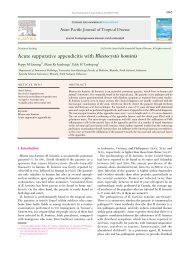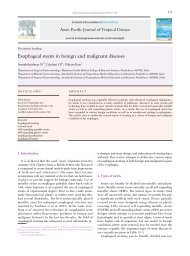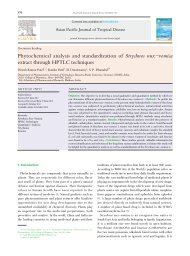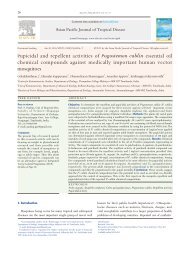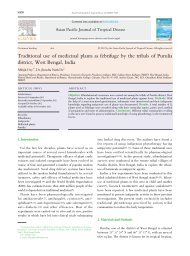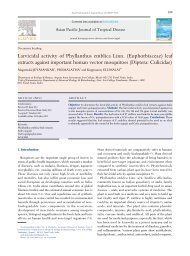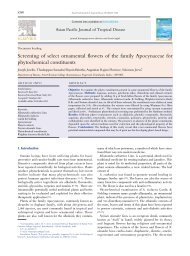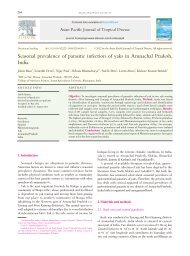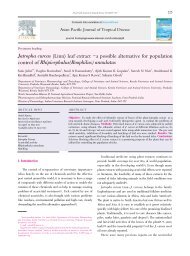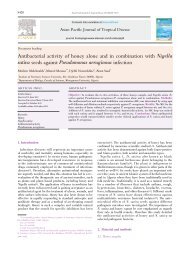Antibacterial activities of some Indian traditional plant extracts
Antibacterial activities of some Indian traditional plant extracts
Antibacterial activities of some Indian traditional plant extracts
You also want an ePaper? Increase the reach of your titles
YUMPU automatically turns print PDFs into web optimized ePapers that Google loves.
Document heading<br />
<strong>Antibacterial</strong> <strong>activities</strong> <strong>of</strong> <strong>some</strong> <strong>Indian</strong> <strong>traditional</strong> <strong>plant</strong> <strong>extracts</strong><br />
N Prasannabalaji *1 , G Muralitharan 1 , RN Sivanandan 2 , S Kumaran 3 and SR Pugazhvendan 4<br />
1 Department <strong>of</strong> Microbiology, School <strong>of</strong> Life Sciences, Bharathidasan University, Tiruchirappali 620 024, Tamilnadu, India.<br />
2 Department <strong>of</strong> Medical Biotechnology, Sri Ramachandra University, Porur, Chennai 600 116, Tamilnadu, India.<br />
3 CAS Marine Biology, Annamalai University, Parangipettai 608 502, Tamilnadu, India.<br />
4 Department <strong>of</strong> Zoology, DDE, Annamalai University, Annamalai Nagar 608 002, Tamilnadu, India<br />
ARTICLE INFO ABSTRACT<br />
Article history:<br />
Received 5 June 2012<br />
Received in revised from 5 July 2012<br />
Accepted 7 Octoberr 2012<br />
Available online 28 October 2012<br />
Keywords:<br />
Proteolytic<br />
Fibrinigenolytic<br />
Hemolytic assay<br />
Phospholipase<br />
Hyaluronidase<br />
MTT assay<br />
1. Introduction<br />
Recently, the World Health Organization reports that at least<br />
75 - 95% <strong>of</strong> the world populations <strong>of</strong> developing countries<br />
were chiefly rely on <strong>traditional</strong> medicines and major part <strong>of</strong><br />
<strong>traditional</strong> therapies involves the use <strong>of</strong> <strong>plant</strong> extract products<br />
or their active constituents [1]. Traditional medicine usage is<br />
a common practice in developed and developing countries<br />
at the primary healthcare level [2]. Due to increased and<br />
indiscriminate use <strong>of</strong> antibiotics for treatment <strong>of</strong> humans<br />
and animals there develops the antibiotic resistance and<br />
multidrug resistance microorganisms like Salmonella spp.<br />
*Corresponding author: N. Prasannabalaji Department <strong>of</strong> Microbiology, School <strong>of</strong> Life<br />
Sciences, Bharathidasan University Tiruchirappalli 620 024 Tamilnadu, India.<br />
Email: applenpb@gmail.com; kumarun23@gmail.com<br />
Asian Pacific Journal <strong>of</strong> Tropical Disease (2012)S291-S295<br />
Contents lists available at ScienceDirect<br />
Asian Pacific Journal <strong>of</strong> Tropical Disease<br />
journal homepage:www.elsevier.com/locate/apjtcm<br />
S291<br />
Objective: To evaluate the in vitro antibacterial activity <strong>of</strong> various solvent <strong>extracts</strong> <strong>of</strong> South<br />
<strong>Indian</strong> <strong>traditional</strong> medicinal <strong>plant</strong>s Ocimum sanctum, Ocimum gratissimum, Aegle marmelos, and<br />
Adhatoda vasica leaves against clinical pathogens <strong>of</strong> human origin. Methods: The antimicrobial<br />
activity <strong>of</strong> different solvents crude extract <strong>of</strong> four medicinal <strong>plant</strong>s used in <strong>traditional</strong> <strong>Indian</strong><br />
medicine was tested by disc diffusion method against five bacterial pathogens: Escherichia coli,<br />
Staphylococcus aureus, Salmonella typhi, Salmonella paratyphi and klebsiella pneumoniae.. The<br />
minimum inhibitory concentration (MIC) and minimum bactericidal concentration (MBC) was<br />
determined for evaluating the potential <strong>plant</strong> extract. Results: The antibacterial results showed<br />
methanol <strong>extracts</strong> (0.4 g/ml) <strong>of</strong> Ocimum gratissimum and Ocimum sanctum showed maximum<br />
zone <strong>of</strong> inhibition (30 mm and 25.5 mm, respectively) against Salmonella typhi. MIC was tested<br />
at various concentrations from 0.625 mg/ml to 0.039 mg/ml for all the <strong>plant</strong> <strong>extracts</strong>. At the lowest<br />
concentration (0.039mg/ml) tested, methanol <strong>extracts</strong> <strong>of</strong> Ocimum gratissimum showed higher MIC<br />
against Salmonella typhi and Salmonella paratyphi where as the methanolic <strong>extracts</strong> <strong>of</strong> Ocimum<br />
gratissimum showed potent activity against Staphylococcus aureus at 0.078 mg/ml. Methanol<br />
extract (0.4 g/ml) <strong>of</strong> Aegle marmelos showed significant inhibitory activity <strong>of</strong> 22.5mm and MIC<br />
value <strong>of</strong> 0.156.mg/ml against E. coli strain. The Klebsiella spp was the most resistant strain <strong>of</strong><br />
all and various concentrations Adhatoda vasica extract showed less activity against the tested<br />
pathogens. Conclusions: The present screening result demonstrated that the <strong>Indian</strong> <strong>traditional</strong><br />
medicinal <strong>plant</strong>s Ocimum sanctum, Ocimum gratissimum, Aegle marmelos methanol leaf extract<br />
has potent antibacterial activity and the studied <strong>plant</strong>s may be new source for novel antibacterial<br />
compound discovery for treating drugs resistant human pathogens.<br />
which has increased a great deal in developing countries [3].<br />
It is estimated that nontyphoidal Salmonella cause between<br />
two hundred million and 1.3 billion cases <strong>of</strong> intestinal<br />
disease including 3 million <strong>of</strong> death each year worldwide<br />
[4]. The demand for more and more drugs from <strong>plant</strong> sources<br />
is continuously increasing which necessitates screening<br />
medicinal <strong>plant</strong>s with promising biological activity [5].<br />
Medicinal <strong>plant</strong>s are gifts <strong>of</strong> nature to cure number <strong>of</strong> diseases<br />
among human beings and a large number <strong>of</strong> <strong>plant</strong>s in different<br />
location around the world have been extracted, semi-purified<br />
to investigate individually their antimicrobial activity. [6].<br />
The <strong>plant</strong> like Ocimum sanctum, Ocimum gratissimum<br />
has a versatile role to play in <strong>traditional</strong> medicines. These<br />
are popularly known as “Thulasi” also tulsi, tulasī, or Holy<br />
Basil is an aromatic <strong>plant</strong> in the family Lamiaceae. Ocimum<br />
sanctum is cultivated for its medicinal purpose as herbal
S292<br />
tea in Ayurveda and religious purpose as performing worship<br />
with leaves across South Asia. It was well documented<br />
already on the bioactive compounds <strong>of</strong> Ocimum sanctum for<br />
medicinal aspects i.e. antimicrobial, adaptogenic, antidiabetic,<br />
hepatoprotective,anti-inflammatory, anti-carcinogenic,<br />
radioprotective, immunomodulatory, chemopreventive, cardioprotective,<br />
and safe guarding against possible deficiencies [7].<br />
Ocimum sanctum <strong>extracts</strong> are effective against Staphylococcus<br />
aureus, E. coli. P. aeruginosa , S. typhimurium and used as<br />
better alternative in food preservation [8]. Ocimum gratissimum<br />
were cultivated in <strong>Indian</strong> houses, temples for pujas and<br />
<strong>traditional</strong> medicinal aspects. These <strong>plant</strong>s were widely<br />
distributed in tropical and warm temperature regions in India<br />
and commonly known as “alfavaca”. It is naturally used in the<br />
treatment <strong>of</strong> different diseases including upper respiratory tract<br />
infections, diarrhea, headache, conjunctivitis, skin diseases,<br />
pneumonia tooth and gum disorders[9].<br />
The <strong>plant</strong> Aegle marmelos belong to family Rutaceae is<br />
commonly known as “Bael” in (Hindi), as “vilvam” in Tamil<br />
and leaves also auspiciously used in <strong>Indian</strong> temples for pujas.<br />
Also the leaves, stem, bark, fruits possess medicinal value<br />
and widely used in treating skin and eye diseases [10]. A.<br />
marmelos leaves extract exhibit broad spectrum antibacterial<br />
and antifungal <strong>activities</strong> [11]. Aegle marmelos solvent extract<br />
were reported to show potential antidiabetic in regeneration<br />
<strong>of</strong> ß-cells, antihyperlipidaemic, antioxidant, radio protective,<br />
hepatoprotective, antiarthritis activity and anti-inflammatory<br />
properties [12 - 18 ]. Because <strong>of</strong> its potent antibacterial activity,<br />
Aegle marmelos <strong>plant</strong>s were used in folk-lore medicine for the<br />
production <strong>of</strong> bioactive compounds and for preliminary health<br />
care [19].<br />
Adhatoda vasica (acanthaceae) known as chue mue, is a stout<br />
straggling prostrate shrubby <strong>plant</strong> with the compound leaves<br />
which gets sensitive on touching. The medicinal properties <strong>of</strong><br />
Adhatoda vasica exert bacteriostatic and bactericidal effects<br />
on both gram positive and gram negative bacteria on animal<br />
models. These effects have been attributed to the peptides,<br />
alkaloids, and flavonols, which are major components in these<br />
<strong>plant</strong>s [20- 21].<br />
The usage <strong>of</strong> <strong>plant</strong> parts as <strong>traditional</strong> medicine is the most<br />
common practice in India, particularly as folk-lore medicines.<br />
Due to continuous usage <strong>of</strong> antibiotics against clinical<br />
pathogens, development <strong>of</strong> drug resistance is a major problem<br />
now-a-days. With this in view, the wild <strong>plant</strong> <strong>extracts</strong> <strong>of</strong><br />
Ocimum sanctum, Ocimum gratissimum, Aegle marmelos, and<br />
Adhatoda vasica was tested for searching a potential source<br />
for new type <strong>of</strong> antibiotics for treating bacterial diseases. The<br />
folk-lore medicinal facts make the present work to investigate<br />
on the antibacterial activity <strong>of</strong> wild <strong>plant</strong> extracted compounds<br />
against clinical pathogenic isolates.<br />
2. Materials and methods<br />
2.1. Collection and identification <strong>of</strong> <strong>plant</strong> materials<br />
The medicinal <strong>plant</strong>s, Ocimum sanctum, Ocimum<br />
gratissimum, Aegle marmelos, and Adhatoda vasica were<br />
N Prasannabalaji et al./Asian Pacific Journal <strong>of</strong> Tropical Disease (2012)S291-S295<br />
collected from Paallar river beds <strong>of</strong> Kanchipuram, Tamilnadu,<br />
India. The taxonomic position <strong>of</strong> the <strong>plant</strong>s were identified and<br />
authenticated. Leaves from the <strong>plant</strong>s were collected in a large<br />
quantity and washed with clear distilled water and dried in an<br />
oven at 60曟 for 5 mins for extraction purposes<br />
2.2. Extraction <strong>of</strong> <strong>plant</strong> materials<br />
250 gm <strong>of</strong> each <strong>plant</strong> leaves were taken for extraction<br />
procedure and grinded in a mortar and pestle separately under<br />
aseptic condition [22]. The solvents extraction was done by<br />
modified method <strong>of</strong> dissolving 5 g <strong>of</strong> dried <strong>plant</strong> powder in<br />
soxhlet apparatus with ethanol, methanol and acetone (200ml)<br />
separately for 24 hrs at 65曟. The <strong>extracts</strong> were concentrated<br />
to dryness in rotary pressure evaporator and stored at 40曟 for<br />
further antimicrobial study [23].<br />
2.3. Preparation <strong>of</strong> test organisms<br />
Staphylococcus aureus, Salmonella typhi, Salmonella<br />
paratyphi, Escherichia coli and Klebsiella pneumoniae were<br />
isolated from the clinical samples obtained from patients<br />
attending Government Hospital, Kanchipuram. Tamilnadu,<br />
India. The organisms were isolated in nutrient agar medium<br />
and selectively cultured at 37曟 for 24 hrs. The bacterial strains<br />
were identified by biochemical and standard antibiogram tests<br />
as per the directions from Bergy’s manual for determinative<br />
bacteriology.<br />
2.4. Antimicrobial assay<br />
2.4.1. <strong>Antibacterial</strong> sensitivity testing using disc diffusion<br />
method<br />
Circular disc <strong>of</strong> 6 mm diameter were made from the whatman<br />
no 1 filter paper. Discs were impregnated with equal volume (50<br />
毺l) <strong>of</strong> each <strong>plant</strong> <strong>extracts</strong> at four different concentrations (0.05<br />
g/ml, 0.1g/ml, 0.2g/ml & 0.4g/ml). The discs were aseptically<br />
placed over plates <strong>of</strong> Muller Hinton agar (MHA ,Difco) seeded<br />
with each <strong>of</strong> test pathogens, and the inoculum was adjusted<br />
to 0.5 Mc Farland turbidometry [22]. The plates were incubated<br />
in an upright position at 37 曟 for 24 hours and the zone <strong>of</strong><br />
inhibition was measured (in mm diameter). Inhibition zones<br />
with diameter less than 12 mm were considered as having low<br />
antibacterial activity. Diameters between 12 and 16 mm were<br />
considered moderately active, and these with >16mm were<br />
considered highly active [24]. The clinical strains were also<br />
tested for their sensitivity against the standard antibiotics,<br />
cipr<strong>of</strong>loxacin (5 mcg), nalidixic acid (10mcg), novobiocin (30<br />
mcg) by the disk diffusion method.<br />
2.4.2. <strong>Antibacterial</strong> activity by microdilution MIC assay<br />
methods<br />
The minimum inhibitory concentration (MIC) was determined<br />
by comparing the various concentrations <strong>of</strong> <strong>plant</strong> <strong>extracts</strong><br />
which have different inhibitory effect and selecting the lowest<br />
concentration <strong>of</strong> extract showing inhibition [25]. The MIC had<br />
done by 96 well U bottom plates. The MIC plates were filled<br />
with Mueller Hinton Agar (MHA) and various concentrations
<strong>of</strong> <strong>plant</strong> <strong>extracts</strong>, antibiotics-cipr<strong>of</strong>loxacin or solvent control.<br />
Finally the MHB medium with overnight test organism (10-8cfu<br />
/ml-1) was equally distributed. All the samples were prepared<br />
in triplicates and incubated at 37 曟for 24 hrs [26].<br />
To determine the MBC, the treated broth culture from well<br />
which is not showing any visible growth in MIC assay was<br />
cultured on new sterile MHA plates. The least concentration<br />
(highest dilution) <strong>of</strong> the extract that inhibits colony formation<br />
on a solid agar medium after incubation at 37 曟 for 24 hr was<br />
considered as MBC [22]<br />
3. Results<br />
The <strong>extracts</strong> <strong>of</strong> Ocimum sanctum, Ocimum gratissimum,<br />
Aegle marmelos and Adhatoda vasica, tested for antibacterial<br />
activity on five human pathogens were presented in Table 1.<br />
The zone <strong>of</strong> inhibition around the disc impregnated with <strong>plant</strong><br />
extract over the lawn <strong>of</strong> bacterial culture plates determined the<br />
antibacterial activity as quantitatively. The result showed that<br />
the antibacterial <strong>activities</strong> <strong>of</strong> <strong>plant</strong> extract were increased with<br />
increasing concentration <strong>of</strong> crude <strong>extracts</strong>. Though the <strong>extracts</strong><br />
showed prominent antibacterial activity against gram negative<br />
(S. typhi, S. paratyphi, E. coli ) and gram positive (S. aureus)<br />
bacteria, only the Klebsiella sp appeared to be resistance with<br />
very less zone <strong>of</strong> inhibition. Among the tested <strong>plant</strong> <strong>extracts</strong><br />
Ocimum gratissimum methonalic extract showed highest<br />
activity <strong>of</strong> 30 mm (0.4g/ml) inhibition zone against S. typhi and<br />
N Prasannabalaji et al./Asian Pacific Journal <strong>of</strong> Tropical Disease (2012)S291-S295 S293<br />
Table 1<br />
<strong>Antibacterial</strong> activity <strong>of</strong> different <strong>plant</strong> extract by disc diffusion method R= no zone <strong>of</strong> inhibition<br />
followed by methanol extract <strong>of</strong> Ocimum sanctum showed 25.5<br />
mm (0.4g/ml) inhibition zone against S. typhi (Table.1). The<br />
Ocimum gratissimum methanol extract also showed maximum<br />
inhibition zone <strong>of</strong> 28 mm (0.4 g/ml) against Salmonella<br />
paratyphi.<br />
On the other hand, the E. coli strain were mostly resistance<br />
to various solvents <strong>of</strong> Adhatoda vasica <strong>plant</strong> extract<br />
and moderately resistant to Ocimum sanctum, Ocimum<br />
gratissimum, while Aegle marmelos methanol extract<br />
demonstrated significant inhibitory activity <strong>of</strong> 22.5mm (0.4 g/<br />
ml) against E. coli strain tested. Also the S. aureus moderately<br />
sensitive to various solvent <strong>extracts</strong> <strong>of</strong> Ocimum sanctum, A.<br />
marmelos, Adhatoda vasica and showed maximum sensitivity<br />
to methanol extract <strong>of</strong> Ocimum gratissimum inhibition with 24<br />
mm (0.4g/ml) zone <strong>of</strong> inhibition.<br />
The Klebsiella sp was resistant to the different concentrations<br />
<strong>of</strong> ethanol, acetone <strong>plant</strong> <strong>extracts</strong> <strong>of</strong> Ocimum sanctum, Aegle<br />
marmelos and Adhatoda vasica, while Ocimum gratissimum<br />
methanol extract demonstrated a inhibition zone <strong>of</strong> 9.0 mm<br />
(0.4g/ml) only. The result showed that S. typhi, S. paratyphi and<br />
S. aureus were the most susceptible species to the different<br />
concentrations <strong>of</strong> methanol extract <strong>of</strong> Ocimum gratissimum<br />
and E. coli susceptible to the <strong>extracts</strong> <strong>of</strong> Aegle marmelos.<br />
The MIC analysis <strong>of</strong> <strong>plant</strong> <strong>extracts</strong> showed the optimum<br />
bacteriostatic and bacteriocidal concentration for methanol<br />
crude <strong>extracts</strong> <strong>of</strong> the <strong>plant</strong>s tested. The table 2 depicted the<br />
MIC and MBC <strong>of</strong> all <strong>plant</strong> <strong>extracts</strong> and the zone <strong>of</strong> inhibition<br />
results reflected in MIC. The MIC <strong>of</strong> all the <strong>plant</strong> <strong>extracts</strong><br />
O.sanctum Ethanol extract (mg/mL) O.sanctum Methanol extract (mg/mL) O. sanctum Acetone extract (mg/mL)<br />
Bacterial species 50 100 200 400 50 100 200 400 50 100 200 400<br />
S. aureus 8.2 9.4 10.2 11.4 12.0 13.5 14.0 14.5 8.0 9.0 10.0 10.5<br />
E.coli R R 6.6 7.8 R R 7.0 7.5 R R R 7.2<br />
S.typhi 10.0 11.5 12.0 14.0 15.0 17.5 22.5 25.5 R 7.0 7.6 8.2<br />
S. paratyphi 8.5 9.6 10.5 12.0 14.0 16.0 19.0 21.0 R 6.0 6.5 7.5<br />
Klebsiella sp R R R 7.0 R.0 7.0 7.0 8.0 R R R 7.2<br />
O. Gratissimum - Methonal <strong>extracts</strong> (mg/mL) O. Gratissimum - Methonal <strong>extracts</strong> (mg/mL) O. Gratissimum Acetone extract (mg/mL)<br />
Bacterial species 50 100 200 400 50 100 200 400 50 100 200 400<br />
S. aureus 8.5 9.5 10.5 12.0 14.0 18.0 22 24.0 R 8.0 9.5 10.5<br />
E.coli R R 6.5 7.0 7.0 8.0 8.5 9.0 R R 6.6 7.2<br />
S. typhi 12.2 14.0 15.5 16.7 19.0 24 28.0 30.0 9.0 10.5 12.2 14.1<br />
S. paratyphi 10 11 12.3 14.5 16.0 22.0 25.0 28.0 7.6 8.6 9.2 10.2<br />
Klebsiella sp R R 7 7.5 R 7.3 8.1 9.0 R R 7.6 8.1<br />
A. Marmelos Ethanol extract (mg/mL) A. marmelos extract (mg/mL) A. Marmelos Acetone extract(mg/mL)<br />
Bacterial species 50 100 200 400 50 100 200 400 50 100 200 400<br />
S. aureus R 7.0 8.5 9.6 11.5 12.5 14 15 R 7.0 7.2 8.5<br />
E.coli R 8.0 9.0 10.5 16 17 17.5 22.5 R 7.0 8.0 9.0<br />
S. typhi R 6.9 8.5 10.2 12 14 17 18 R R 8.0 8.6<br />
S. paratyphi R 7.0 7.6 8.2 9.0 10.5 11 11 R R 7.0 7.0<br />
Klebsiella sp R R R 7 R R R 8.5 R R R R<br />
A.vasica Ethanol extract (mg/mL) A. vasica Methanol extract (mg/mL) A.vasica Acetone extract(mg/mL)<br />
Bacterial species 50 100 200 400 50 100 200 400 50 100 200 400<br />
S. aureus R R R 7 R R R 7.2 R R R 6.9<br />
E.coli R 7.0 8.1 8.5 R 8.0 8.0 9.0 R R R 7.2<br />
S. typhi R R R R R R 7.0 7.3 R R R R<br />
S. paratyphi R R R R R R R R R R R R<br />
Klebsiella sp R R R R R R R R R R R R
S294<br />
was studied from the range <strong>of</strong> 0.625 to 0.039 mg/ml. The <strong>plant</strong><br />
methanol extract showing more than 7 mm zone <strong>of</strong> inhibition<br />
was taken as observable MIC value (Table 2). The MIC Value <strong>of</strong><br />
Ocimum gratissimum methanol extract for the bacterial strains<br />
S. typhi and S. paratyphi were 0.039.mg/ml (MIC=MBC). The<br />
E. coli appeared to be sensitive with a zone <strong>of</strong> inhibition <strong>of</strong><br />
22.5 mm and the MIC value <strong>of</strong> 0.156 mg/ml for Aegle marmelos<br />
respectively. The gram positive Staphylococcus aureus were<br />
4. Discussion<br />
The Medicinal <strong>plant</strong>s have been main source for drugs over<br />
many centuries in many countries, in both developed and<br />
developing world. Traditional medicines products are not<br />
<strong>of</strong>ficially recognized in many countries, and the European<br />
union presently developing regulatory laws for quality<br />
<strong>traditional</strong> medicines [1]. It is estimated that at least 25% <strong>of</strong> all<br />
modern medicines are derived either directly or indirectly from<br />
medicinal <strong>plant</strong>s. Traditional medicines play important role<br />
in world health treating millions <strong>of</strong> people [1]. The medicinal<br />
property <strong>of</strong> herbs is due to the presence <strong>of</strong> different complex<br />
chemical substance as secondary metabolites, which are<br />
exclusively accumulated in different parts <strong>of</strong> the <strong>plant</strong>s [22].<br />
The tropical, subtropical regions <strong>of</strong> India are rich with various<br />
kinds <strong>of</strong> herbs/<strong>plant</strong> species with good medicinal properties.<br />
The <strong>plant</strong> <strong>extracts</strong> contain wide range <strong>of</strong> secondary metabolites<br />
such as flavonoides, , terpenoids, tannins, glycosides and<br />
alkaloids. These natural metabolites are important as potential<br />
antimicrobial crude drug and source for natural compounds<br />
as new anti-infection agents. [27]. The occurrence <strong>of</strong> bacterial<br />
diseases is becoming common in south Asia particularly in<br />
India, because <strong>of</strong> development <strong>of</strong> antibacterial drug resistant<br />
pathogens. To resolve the problem and to detect alternative<br />
chemotherapeutic agents, the search for novel forms from<br />
newer sources is global challenges [22].<br />
Our present investigation for the newer antibacterial bioactive<br />
compounds targetted on the unexplored folk medicinal <strong>plant</strong>s,<br />
being used for centuries in treating local population. The <strong>plant</strong><br />
<strong>extracts</strong> are considered as best source <strong>of</strong> bioactive compounds<br />
particularly for <strong>traditional</strong> healers as they contain components<br />
<strong>of</strong> therapeutic values. The bioactive compounds have been<br />
detected for either bacteriostatic or bacteriocidal property<br />
and have very minimum or no toxicity to host. In this study,<br />
three different polarity <strong>plant</strong> <strong>extracts</strong> , Ocimum sanctum,<br />
N Prasannabalaji et al./Asian Pacific Journal <strong>of</strong> Tropical Disease (2012)S291-S295<br />
Table 2<br />
The minimum inhibitory concentration (MIC) and Minimal Bactericidal Concentration (MBC)<br />
the moderate sensitive <strong>of</strong> all against all the <strong>extracts</strong> tested,<br />
while the Ocimum gratissimum methanol crude extract shows<br />
maximum zone <strong>of</strong> inhibition <strong>of</strong> 24 mm and MIC <strong>of</strong> 0.078 mg/ml<br />
respectively. From MIC results <strong>of</strong> present study the methanol<br />
<strong>extracts</strong> <strong>of</strong> Ocimum gratissimum and Aegle marmelos showed<br />
prominent inhibitory action against all the pathogens tested,<br />
which indicates its possible application for antibacterial<br />
activity.<br />
Plants/Bacterium Ocimum sanctum Ocimum gratissimum A. Marmelos A.vasica +control Cf<br />
S.a 0.156 mg/mL 0.078 mg/mL 0.312 mg/mL 0.625 mg/mL 0.001mg/mL<br />
E.c 0.625 mg/mL 0.0625 mg/mL 0.156 mg/mL 0.625 mg/mL 0.002mg/mL<br />
S.t 0.156 mg/mL 0.039 mg/mL 0.625mg/mL 0.625 mg/mL 0.004mg/mL<br />
S.pt 0.156 mg/mL 0.039 mg/mL 0.625 mg/mL - 0.001mg/mL<br />
K.n - - - - 0.002mg/mL<br />
S.a : Staphylococcus aureus, E.c : Escherichia coli, S.t : Salmonella typhi, S.pt : Salmonella paratyphi, K.n : Klebsiella pneumonia , -: Not Determined,<br />
+ve control cf : cipr<strong>of</strong>loxin.<br />
Ocimum gratissimum, Aegle marmelos, Adhatoda vasica have<br />
been tested for antimicrobial activity on five different human<br />
clinical pathogens viz. Staphylococcus aureus, Salmonella<br />
typhi, Salmonella paratyphi, Escherichia coli and Klebsiella<br />
pneumoniae. In an earlier study Bishnu et al [28] observed that<br />
Ocimum sanctum and other natural <strong>plant</strong>s <strong>extracts</strong> inhibit the<br />
growth <strong>of</strong> similar clinical pathogens. Among the three different<br />
<strong>extracts</strong> Ocimum gratissimum methanol extract showed<br />
highest antibacterial activity with a MIC <strong>of</strong> 0.039 mg/ml against<br />
Salmonella typhi , Salmonella paratyphi and MIC <strong>of</strong> 0.078 mg/<br />
ml active against Staphylococcus aureus. Similarly Adebolu<br />
et al [29] reported the steam distillation <strong>extracts</strong> <strong>of</strong> Ocimum<br />
gratissimum were highly effective against Salmonella typhi,<br />
Staphylococcus aureus and E. coli strains.<br />
Apart from Salmonella typhi infection, Salmonella paratyphi<br />
A and B also widely persist in <strong>Indian</strong> population. The present<br />
study reported, methanol <strong>extracts</strong> <strong>of</strong> Ocimum gratissimum<br />
showed considerable inhibitory activity against both enteric<br />
isolates <strong>of</strong> Salmonella typhi , Salmonella paratyphi and reports<br />
<strong>of</strong> such similar work on enteric Salmonella paratyphi from<br />
scientific group is very minimal. The methanol extract <strong>of</strong><br />
Aegle marmelos showed potent antimicrobial activity against<br />
clinical pathogenic E. coli; while suresh et al [30] showed that<br />
Aegle marmelos leaf <strong>extracts</strong> having reasonable antibacterial<br />
activity against E. coli. In fact the results <strong>of</strong> different <strong>extracts</strong><br />
<strong>of</strong> Adhatoda vasica shows less antibacterial activity against the<br />
clinical pathogenic isolates. On the other hand the Klebsiella<br />
spp was the most resistant <strong>of</strong> all the tested <strong>plant</strong> <strong>extracts</strong> and<br />
it is suggested that this bacterial strains may possess resistant<br />
mechanism and concentration <strong>of</strong> compound used may be<br />
lesser to inactivate the bacterial activity.<br />
The results <strong>of</strong> the present study along with early reports<br />
concluded that the methanol <strong>extracts</strong> <strong>of</strong> <strong>traditional</strong><br />
wild <strong>plant</strong> Ocimum gratissimum, Ocimum sanctum has<br />
potent antibacterial activity against the clinical human<br />
pathogens isolates particularly pathogenic Salmonella<br />
typhi and salmonella paratyphi. The <strong>traditional</strong>ly used
Aegle marmelosleaves methanol <strong>extracts</strong> possess effective<br />
antibacterial activity against E. coli. The present investigation<br />
data on antibacterial potency <strong>of</strong> wild Ocimum sanctum,<br />
Ocimum gratissimum, Aegle marmeloshelps to design further<br />
study for synthesis <strong>of</strong> novel antibiotics.<br />
References<br />
[1] Molly Meri Robinson Classifications, Terminology and Standards,<br />
WHO, Geneva :Xiaorui Zhang Traditional Medicines, WHO. 2011.<br />
<strong>traditional</strong> medicines: global situation, issues and challenges. 3rd<br />
Edition.<br />
[2] Essawi T, Srour M. Screening <strong>of</strong> <strong>some</strong> Palestinian medicinal <strong>plant</strong>s for<br />
antibacterial activity. J Ethnopharmacology 2000 ;70 : 343-349.<br />
[3] Gordana Mijovic , Bogdanka Andric , Dragica Terzic , Milena Lopicic<br />
, Brankica Dupanovic. Antibiotic Susceptibility Of Salmonella Spp.: A<br />
Comparison Of Two Surveys With A 5 Years Interval. Journal <strong>of</strong> IMAB<br />
- Annual Proceeding (Scientific Papers) 2012; 18:1. 216 -219 .<br />
[4] Goburn B, Grassl GA, Finlay BB. Salmonella, the host and disease: A<br />
brief review. Immunol. Cell. Biol. 2007; (85): 112-118.<br />
[5] Sumathi P , Parvathi A. Antimicrobial activity <strong>of</strong> <strong>some</strong> <strong>traditional</strong><br />
medicinal <strong>plant</strong>s. Journal <strong>of</strong> Medicinal Plants Research 2010; 4(4): 316-<br />
321.<br />
[6] Vadlapudi Varahalarao, Chandrashekar N K, In Vitro Bioactivity Of<br />
<strong>Indian</strong> Medicinal Plant Calotropis Procera (Ait.). Journal <strong>of</strong> Global<br />
Pharma Technology 2010; 2(2): 43-45.<br />
[7] Ekta Singh, Sheel Sharma, Jaya Dwivedi, Swapnil Sharma. Diversified<br />
Potentials Of Ocimum sanctum Linn (Tulsi): An Exhaustive Survey. J.<br />
Nat. Prod. Plant Resour., 2012; 2 (1):39-48.<br />
[8] Poonam Mishra, Saniav Mishra . Study <strong>of</strong> antibacterial activity <strong>of</strong><br />
Ocimum sanctum extract against gram positive and gram negative<br />
bacteria. American journal <strong>of</strong> food technology 2011; 6(4): 336-341.<br />
[9] Okigbo RN, Ogbonnanya OU . Antifungal effects <strong>of</strong> two tropical <strong>plant</strong>s<br />
<strong>extracts</strong> Ocimum gratissimum and Afromaomum melegueta on post<br />
harvest yam Discorea spp rot. Afr J Biotechnol 2006; 5 (9): 727-731.<br />
[10] Kingston C , Jeeva S , Jeeva G M , Kiruba S, Mishra B P , Kannan D .<br />
Indigenous Knowledge Of Using Medicinal Plants In Treating Skin<br />
Diseases In Kanyakumari District , Southern India. <strong>Indian</strong> journal <strong>of</strong><br />
<strong>traditional</strong> knowledge 2009; 8(2):196-200.<br />
[11] Rajeshwari Sivaraj, Balakrishnan A, Thenmozhi M, Venckatesh R.<br />
Antimicrobial activity <strong>of</strong> Aegle marmelos, Ruta graveolens, Opuntia<br />
dellini, Euphorbia royleana and Euphorbia antiquorum. Journal <strong>of</strong><br />
Pharmacy Research 2011; 4: 1507-1508.<br />
[12] Gopalsamy Rajiv Gandhi, Savarimuthu Ignacimuthu , Michael<br />
Gabriel Paulraj . Hypoglycemic and ß-cells regenerative effects<br />
<strong>of</strong> Aegle marmelos (L.) Corr. Bark extract in streptozotocin-induced<br />
diabetic rats. Food and Chemical Toxicology 2012; 50: 1667-1674.<br />
[13] Vijaya C, Ramanathan M, Suresh B. Lipid lowering activity <strong>of</strong> ethanolic<br />
<strong>extracts</strong> <strong>of</strong> leaves <strong>of</strong> Aegle marmelos (linn.) in hyperlipidaemic models<br />
<strong>of</strong> wistar albino rats. <strong>Indian</strong> journal <strong>of</strong> experimental biology 2009 ; 47<br />
(3): 182-185.<br />
[14] Vanitha Reddy P, Sahana N, Asna Urooj . Antioxidant activity <strong>of</strong> Aegle<br />
marmelos and Pisidium Guajava leaves. Int.J. Med.Arom.Plants 2012;<br />
2 (1): 155-160.<br />
[15] Manjeshwar Shrinath Baliga, Harshith P, Bhat, Manisha Maria Pereira,<br />
Nishan Mathias, Ponemone Venkatesh. Radioprotective Effects <strong>of</strong><br />
Aegle marmelos (L.) Correa (Bael): A Concise Review. The Journal <strong>of</strong><br />
N Prasannabalaji et al./Asian Pacific Journal <strong>of</strong> Tropical Disease (2012)S291-S295 S295<br />
Alternative and Complementary Medicine 2010; 16(10): 1109-1116.<br />
[16] Sumitha P, Thirunalasundari T. Hepatoprotective Activity <strong>of</strong> Aegle<br />
marmelos in CCl4 Induced Toxicity - An In-vivo Study. Journal <strong>of</strong><br />
Phytology 2011; 3(9): 05-09<br />
[17] Benni JM, Jayanthi MK, Suresha RN. Evaluation <strong>of</strong> the antiinflammatory<br />
activity <strong>of</strong> Aegle marmelos (Bilwa) root. <strong>Indian</strong> J<br />
Pharmacol 2011; 43: 393-397.<br />
[18] Trivedi HP, Pathak NL, Gavaniya, MG, Patel AK, Trivedi HD,<br />
Panchal NM. International Journal <strong>of</strong> Pharmaceutical Research and<br />
Development 2011; 3: 38-45.<br />
[19] Saradha JK, SubbaRao B. <strong>Antibacterial</strong> Activity <strong>of</strong> Extracts from Aegle<br />
marmelos against Standard Pathogenic Bacterial Strains. International<br />
Journal <strong>of</strong> PharmTech Research 2010; 2( 3): 1824-1826.<br />
[20] Umamaheswari M, Chaterjee TK. In vitro antioxidant <strong>activities</strong> <strong>of</strong><br />
the fractions <strong>of</strong> Coccinia grandis L. leaf extract. African Journal <strong>of</strong><br />
Traditional, Complementary and Alternative Medicines 2007; 5: 61-73.<br />
[21] Vinothapooshan G, Sundar K. Wound Healing Effect Of Various<br />
Extracts Of Adhatoda vasica. International Journal <strong>of</strong> Pharma and<br />
Bio Sciences 2010; 1(4):530-536.<br />
[22] Haniyeh Koochak, Seyyed Mansour Seyyednejad, Hussein Motamedi.<br />
Preliminary study on the antibacterial activity <strong>of</strong> <strong>some</strong> medicinal<br />
<strong>plant</strong>s <strong>of</strong> Khuzestan (Iran). Asian Pacific Journal <strong>of</strong> Tropical Medicine<br />
2010; 3(3)180-184.<br />
[23] Nwinyi Obinna C, Chinedu Nwodo S, Ajani Olayinka O, Ikpo<br />
Chinwe O, Ogunniran Kehinde O. <strong>Antibacterial</strong> effects <strong>of</strong> <strong>extracts</strong> <strong>of</strong><br />
Ocimum gratissimum and piper guineense on Escherichia oli and<br />
Staphylococcus aureus. African Journal <strong>of</strong> Food Science 2009; 3(1):<br />
022-025.<br />
[24] Indu MN, Hatha AAM, Abirosh C, Harsha U, Vivekanandan G.<br />
Antimicrobial Activity <strong>of</strong> Some <strong>of</strong> The South-<strong>Indian</strong> Spices Against<br />
Serotypes <strong>of</strong> Escherichia Coli, Salmonella, Listeria Monocytogenes<br />
and Aeromonas Hydrophila. Brazilian Journal <strong>of</strong> Microbiology 2006;<br />
37:153-158.<br />
[25] Agatemor C . Antimcrobial activity <strong>of</strong> aqueous and ethanol <strong>extracts</strong> <strong>of</strong><br />
nine Nigerian spices against four food borne bacteria. Elec J Environ<br />
Agric food chem 2009; 8(3): 195-200.<br />
[26] Shahbudin Saad , Muhammad Taher , Deny Susanti , Haitham Qaralleh<br />
, Nurul Afifah Binti AbdulRahim. Antimicrobial activity <strong>of</strong> mangrove<br />
<strong>plant</strong> (Lumnitzera littorea) . Asian Pacific Journal <strong>of</strong> Tropical Medicine<br />
2011; 4(7) 523-525.<br />
[27] Dwivedi SC, Dudey R, Richa tyagi, Meeta Masand, Uma Advani.<br />
Medicinal Bioactives as antimicrobial agents : an overview.<br />
International journal <strong>of</strong> pharmaceutical research and development<br />
2011: 3(7) 24-30.<br />
[28] Bishnu J, Govind Prasad S, Buddha BB, Megh RB, Dinita S,<br />
Krishna S, et al. Phytochemical extraction and antimicrobial<br />
properties <strong>of</strong> different medicinal <strong>plant</strong>s: Ocimum sanctum (Tulsi),<br />
Eugenia caryophyllata (Clove), Achyranthes bidentata (Datiwan)<br />
and Azadirachta indica (Neem). Journal <strong>of</strong> Microbiology and<br />
Antimicrobials 2011; 3(1): 1-7.<br />
[29] Adebolu TT, Oladimeji SA. Antimicrobial activity <strong>of</strong> leaf <strong>extracts</strong><br />
<strong>of</strong> Ocimum gratissimum on selected diarrhoea causing bacteria in<br />
Southwestern Nigeria. African Journal <strong>of</strong> Biotechnology 2005; 4(7):<br />
682-684.<br />
[30] Suresh K, Senthilkumar PK, Karthikeyan B. Antimicrobial activity <strong>of</strong><br />
Aegle marmelos against clinical pathogens. Journal <strong>of</strong> Phytology 2009;<br />
1(5): 323-327.



